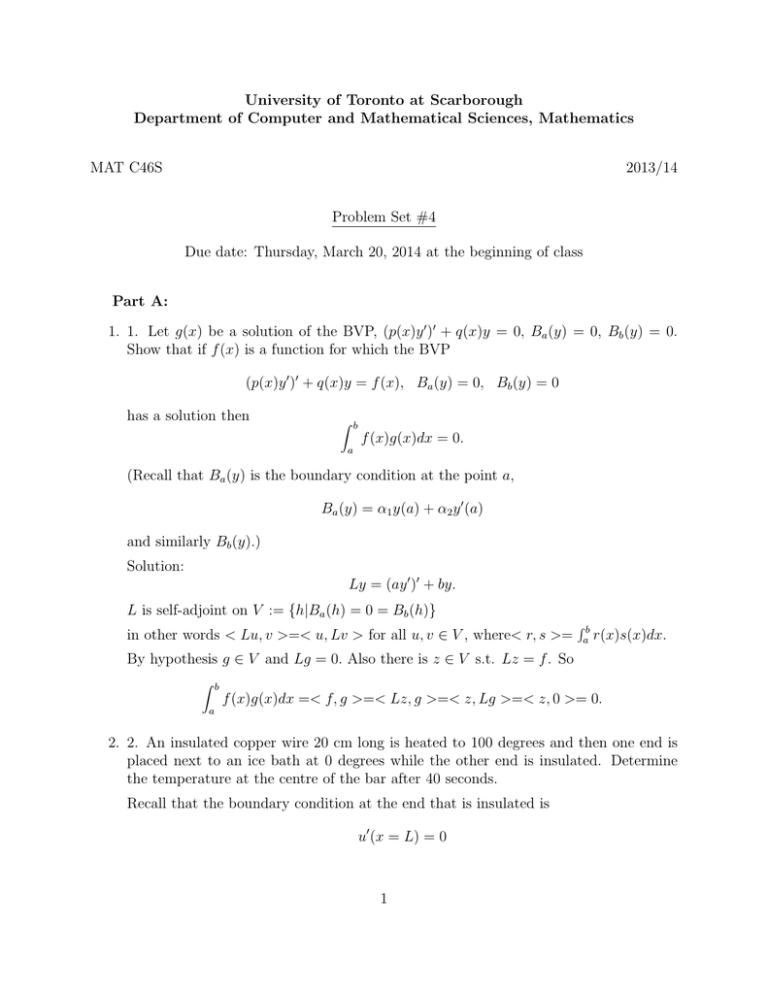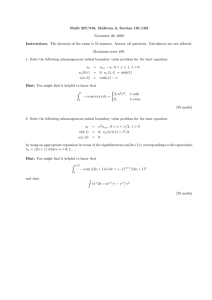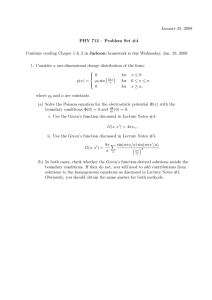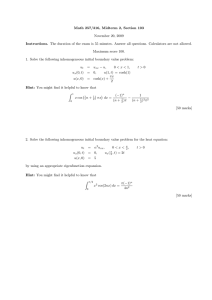Solution - University of Toronto
advertisement

University of Toronto at Scarborough
Department of Computer and Mathematical Sciences, Mathematics
MAT C46S
2013/14
Problem Set #4
Due date: Thursday, March 20, 2014 at the beginning of class
Part A:
1. 1. Let g(x) be a solution of the BVP, (p(x)y ′ )′ + q(x)y = 0, Ba (y) = 0, Bb (y) = 0.
Show that if f (x) is a function for which the BVP
(p(x)y ′ )′ + q(x)y = f (x), Ba (y) = 0, Bb (y) = 0
has a solution then
Z
b
a
f (x)g(x)dx = 0.
(Recall that Ba (y) is the boundary condition at the point a,
Ba (y) = α1 y(a) + α2 y ′ (a)
and similarly Bb (y).)
Solution:
Ly = (ay ′ )′ + by.
L is self-adjoint on V := {h|Ba (h) = 0 = Bb (h)}
in other words < Lu, v >=< u, Lv > for all u, v ∈ V , where< r, s >=
By hypothesis g ∈ V and Lg = 0. Also there is z ∈ V s.t. Lz = f . So
Z
b
a
Rb
a
r(x)s(x)dx.
f (x)g(x)dx =< f, g >=< Lz, g >=< z, Lg >=< z, 0 >= 0.
2. 2. An insulated copper wire 20 cm long is heated to 100 degrees and then one end is
placed next to an ice bath at 0 degrees while the other end is insulated. Determine
the temperature at the centre of the bar after 40 seconds.
Recall that the boundary condition at the end that is insulated is
u′ (x = L) = 0
1
while the boundary condition at the end in the ice bath is
u(x = 0) = 0
.
(Note that according to Table 10.5.1 in the text on p. 612, the value of the constant
α2 in the heat equation α2 uxx = ut is 1.14.)
Solution:
α2 uxx = ut .
u(0, t) = 0 and ux (20, t) = 0 for all t.
u(x, 0) = 100 for 0 < x < 20.
Set
u(x, t) = X(x)T (t)
so
α2 X ′′ T = XT ′
so
α2 X ′′ /X = −λ = T ′ /T
for some λ.
Hence
α2 X ′′ + λX = 0
(1)
T ′ + λT = 0
(2)
u(0, t) = 0,
(3)
ux (20, t) = 0,
(4)
u(x, 0) = 100, 0 ≤ x ≤ 20
(5)
The boundary conditions give
From (4) we have X(x)T (0) = 100, so T (0) 6= 0. From (3) we have X(0)T (t) = 0 for
all t, so X(0) = 0. From (4) we have X ′ (20)T (t) = 0 for all t, so X ′ (20) = 0.
Hence
α2 X ′′ + λX = 0
and X(0) = 0 and X ′ (20) = 0. We need a nonzero solution since X = 0 doesn’t satisfy
(5).
The boundary conditions are X(0) = 0, X ′ (20) = 0.
Case 1: λ < 0
Let λ = −κ2 , κ > 0.
2
X1 = eκx/2 , X2 = e−κx/2 . We need
X1′ = κeκx/2 ,
X2′ = −κe−κx/2
X(t) = c1 eκx + c2 e−κx
X(0) = 0 tells us c1 = −c2 so X(x) = c sinh κx.
So X ′ (x) = cκ cosh κx. So X ′ (20) = cκ cosh 20κ = 0 tells us cosh 20κ = 0 which is a
contradiction (cosh(x) is never zero for any x).
Case 2: λ = 0
Here X(x) = a + bx, X ′ (x) = b.
X(0) = 0 tells us a = 0.
X ′ (20) = 0 tells us b = 0. So the only solution is X(x) = 0.
Case 3: λ > 0.
Let λ = k 2 , k > 0.
X1 = cos kx/α, X2 = sin kx/α, B0 (X1 ) = 1, B0 (X2 ) = 0
X1′ = −k/α sin kx/α, X2′ = −k/α cos kx/α, B20 (X1 ) = −k/α sin 20k/α, B20 (X2 ) = k/α cos 20k/α
So
20k/α = (2n − 1)/2π, n = 1, 2, 3, . . .
So
λn =
α2 π 2
((2n − 1)/2)2
202
Let X = c1 X1 + c2 X2 . 0 = X(0) = c1 + 0, so C1 = 0.
Hence φn = sin((2n − 1)πx/40) and
< φn , φn >=
= 20
Z
1
0
Z
2
0
0 sin (2n − 1)πx/(40)dx = 20
1 − cos
f (x) = 100, so
< f, φn >= −
=
2
Z
20
0
Z
1
0
sin2 (2n − 1)πv/2dv)
(2n − 1)πv
sin(2n − 1)v v=1
dv = 10(v −
| = 10.
2
(2n − 1)π v=0
100 sin
Z 1
(2n − 1)πx
dx = 2000
sin((2n − 1)πv/2)dv
40
0
4000
4000
(− cos((2n−1)πv/2)|v=1
(1−cos(2n−1)π/2) = 4000/((2n−1)π)
v=0 =
(2n − 1)π
(2n − 1)π
3
So f =
P
n bn φ n
where bn = 400/((2n − 1)π).
2 2
For φn (x) the corresponding T satisfies T ′ +λn T = 0, λn = α40π2 (2n−1)2 so T = Ae−λn t .
Let
un = e−λn t sin(2n − 1)πnx/40.
Then
u(x, t) =
∞
X
bn e−λn t sin
n=1
(2n − 1)πx
40
with bn, λn as above.
x = 10, t = 10 :
u(10, 40) =
∞
X
n=1
where an =
√
2
−1
bn e
−40λn
sin (2n − 1)π/4 =
∞
X
an bn e−40λn
n=1
√ −1
when n = 1, 2 mod 4 an = − 2 when n = 3, 4 mod 4 Thus
400 1 −α2 π2 /40
1 −α2 π2 ·9/(40)
1 −α2 π2 ·25/(40)
1 −α2 π2 ·49/(40)
u(10, 40) = √
e
+
e
−
e
−
e
+ ···
3π
5π
7π
2 π
= 67.957 + 2.387 − 0.016 + · · · ∼
= 70.3
It will be approximately 70.3 degrees in the centre of the wire after 40 seconds.
Question 3.
Show that if f ≥ 0 then the eigenvalue problem y ′′ + λf (x)y = 0, y(0) = 0, y(1) = 0
cannot have any negative eigenvalues.
Solution:
We know y(0) = 0. Consider the smallest zero of y other than x = 0, call it b. So for
0 < x < b, y(x) is not 0. We may assume y(x) > 0 for that range (otherwise replace y by
−y).
Now let z be the maximum of y(x) with 0 < x < b
Then y ′ (z − e) > 0 and y ′ (z + e) < 0 for small enough e (because y ′ (z) = 0). Integrate y ′′
between z − e and z + e: the integral is y ′ (z + e) − y ′ (z − e), so it is < 0. But if lambda < 0,
because f (x) is greater than or equal to 0, y ′′ has the same sign as y. (in other words it is
> 0). This is a contradiction.
Part B:
Do the following problems from Boyce-Di Prima.
Section 10.6 #8 Find the steady-state solution of the heat conduction equation α2 uxx = ut
that satisfies the following set of boundary conditions:
u(0, t) = T, ux (L, t) + u(L, t) = 0
4
Solution: The steady state solution v(x) satisfies the differential equation v ′′ (x) = 0 along
with the boundary conditions
v(0) = T,
v ′ (L) + v(L) = 0
The general solution of this ODE is v(x) = Ax + B. The boundary condition v ′ (0) = 0
requires that B = T . It follows that v(x) = Ax + T , and v ′ (L) + v(L) = A + AL + T. The
second boundary condition requires that A = −T /(1 + L). Hence
v(x) = −T x/(1 + L) + T.
Section 10.7#12
Dimensionless variables can be introduced into the wave equation a2 uxx = utt as follows:
(a) Let s = x/L and show that the wave equation becomes
a2 uxx = L2 utt
(b) Let τ = at/L and show that the wave equation becomes uxx = utt
Solution:
The wave equation is given by
∂ 2u
∂ 2u
a2 2 = 2 .
∂x
∂t
Setting s = x/L, we have
∂u ∂s
1 ∂u
∂u
=
=
.
∂x
∂s ∂x
L ∂s
It follows that
∂ 2u
1 ∂ 2u
=
.
∂x2
L ∂s2
Likewise, with τ = at/L,
∂u
a ∂u
=
∂t
L ∂τ
and
a2 ∂ 2 u
∂ 2u
=
∂t2
L2 ∂τ 2
Substitution into the original equation results in
∂ 2u
∂ 2u
=
.
∂s2
∂τ 2
Section 10.8 #2: Find the solution u(x, t) of Laplace’s equation in 0 < x < a, 0 < y < b
with the boundary conditions
u(0, y) = 0, u(a, y) = 0, 0 < y < b
u(x, 0) = h(x), u(x, b) = 0, 0 ≤ x ≤ a.
5
Solution: Using the method of separation of variables, write u(x, y) = X(x)Y (y). We
arrive at the ordinary differential equation
X ′′ + λX = 0,
with X(0) = X(a) = 0, and
Y ′′ − λY = 0
with Y (b) = 0. It follows that λn = (nπ/a)2 and Xn (x) = sin(nπx/a). Write the solution of
the other ODE as
Y (y) = d1 cosh λ(b − y) + d2 sinh λ(b − y).
Imposing the boundary condition, we have d1 = 0. Hence the fundamental solutions are
given by
un (x, y) = sin(nπx/a) sinh λn (b − y).
The general solution is
u(x, y) =
∞
X
n=1
cn sin(nπx/a) sinh(λn (b − y)/a).
Based on the boundary condition,
h(x) =
∞
X
cn sin(nπx/a) sinh(nπb/a).
n=1
The coefficients are calculated using the equation
cn sinh(nπb/a) = 2/a(
Z
a
0
h(x) sin(nπx/a)dx.
Section 10.8 #9 Show that the equation (23) has periodic solutions only if λ is real.
Solution: Consider the equation Θ′′ + λΘ = 0. Let λ = −µ2 , where µ = ν + iσ. The ODE
can then be written as Θ′′ − (ν + iσ)2 Θ = 0.
The general solution is
Θ(θ) = c1 e(ν+iσ)t + c2 e−(ν+iσ)t .
Collecting the real and imaginary parts,
Θ(θ) = (c1 eνt + c2 e−νt ) cos(σt) + i(c1 eνt − c2 e−νt ) sin(σt).
For ν 6= 0, the functions eνt and e−νt are linearly independent. If the coefficients are nonzero,
then the real and imaginary parts of Θ(θ) are not periodic. So Equation (23) in Section 10.8
has periodic solutions only if λ = −(iσ)2 = σ 2 , with σ > 0.
6





